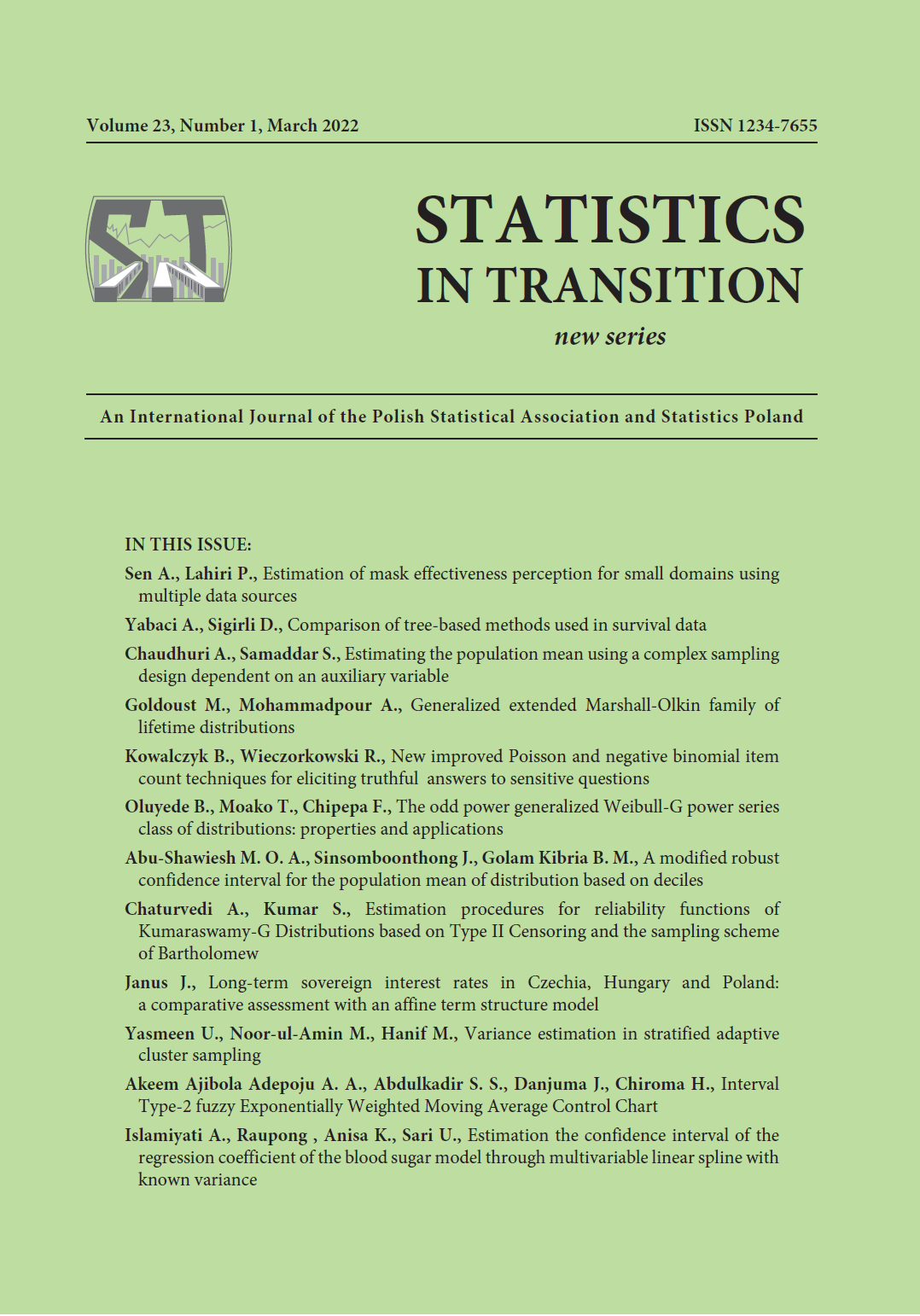ARTICLE
ABSTRACT
This paper provides a comparative evaluation of the behaviour of long-term sovereign yields in Czechia, Hungary and Poland from 2001 to 2019. An affine term structure model developed by Adrian, Crump and Moench (2013) is used as an empirical framework for the decomposition of the bond yields into term premium and risk-neutral components. We document a substantial compression in term premia which started in Central European economies around 2013 and played a decisive role in the changes that occurred in 10-year sovereign yields. This pattern, however, was more prevalent in Czechia and Poland than in Hungary. We show that long-term rates in all three economies remained higher than in Germany due to relatively large risk-neutral components. Nevertheless, cross-country correlations became increasingly dependent on term premium dynamics, both among Central European economies and between each of them and Germany. These results are robust to bias-correction in the baseline models and interpreted in the light of the general interest rates decline in the global economy. Potential policy implications are also discussed.
KEYWORDS
long-term interest rates, affine term structure model, term premium, risk-neutral rates, Central Europe.
REFERENCES
Abbritti, M., Dell’Erba, S., Moreno, A., Sola, S., (2018). Global factors in the term structure of interest rates. International Journal of Central Banking, 14(2), pp. 301–339.
Adrian, T., Crump, R. K., Moench, E., (2013). Pricing the term structure with linear regressions. Journal of Financial Economics, 110(1), pp. 110–138.
Albagli, E., Ceballos, L., Claro, S., Romero, D., (2019). Channels of US monetary policy spillovers to international bond markets. Journal of Financial Economics, 134(2), pp. 447–473.
Bauer, M. D., Hamilton, J. D., (2018). Robust bond risk premia. Review of Financial Studies, 31(2), pp. 399–448.
Blanchard, O., (2019). Public debt and low interest rates. American Economic Review, 109(4), pp. 1197–1229.
Caballero, R. J., Farhi, E., Gourinchas, P. O., (2017). The safe assets shortage conundrum. Journal of Economic Perspectives, 31(3), pp. 29–46.
Cohen, B. H., Hördahl, P., Xia, D., (2018). Term premia: models and some stylised facts. BIS Quarterly Review, September, pp. 79–91.
Dec, M., (2021). Parsimonious yield curve modeling in less liquid markets, GRAPE Working Papers, 52.
Duffee, G. R., (2002). Term premia and interest rate forecasts in affine models. Journal of Finance, 57(1), pp. 405–443.
Dvorák, M., Komárková, Z., Kucera, A., (2019). The Czech Government Yield Curve Decomposition at the Lower Bound. Czech Journal of Economics and Finance, 69(1), pp. 2–36.
Eggertsson, G. B., Mehrotra, N. R., Summers, L. H., (2016). Secular Stagnation in the Open Economy. American Economic Review, 106(5), pp. 503–507.
Grabowski, W., Stawasz-Grabowska, E., (2020). How have the European central bank’s monetary policies been affecting financial markets in CEE-3 countries? Eurasian Economic Review, 11, pp. 43–83.
Gürkaynak, R. S., Sack, B., Wright, J. H., (2007). The U.S. Treasury yield curve: 1961 to the present. Journal of Monetary Economics, 54(8), pp. 2291–2304.
Gürkaynak, R. S., Wright, J. H., (2012). Macroeconomics and the term structure. Journal of Economic Literature, 50(2), pp. 331–367.
Holston, K., Laubach, T., Williams, J. C., (2017). Measuring the natural rate of interest: International trends and determinants. Journal of International Economics, 108, pp. S59–S75.
Horváth, D., Kálmán, P., Kocsis, Z., Ligeti, I., (2014). What factors influence the yield curve? MNB Bulletin, 9(1), pp. 28–39.
Jabłecki, J., Raczko, A., Wesołowski, G., (2016). Negative bond term premia - a new challenge for Polish conventional monetary policy. BIS Papers, 89, pp. 303–315.
Janus, J., (2020). Is ECB Rocking the Boat? Unconventional Monetary Policy in the EMU and Volatility Spillovers to Poland. Eastern European Economics, 58(1), pp. 50–67.
Joslin, S., Priebsch, M., Singleton, K. J., (2014). Risk premiums in dynamic term structure models with unspanned macro risks. Journal of Finance, 69(3), pp. 1197–1233.
Kilian, L., (1998). Small-sample confidence intervals for impulse response functions. Review of Economics and Statistics, 80(2), pp. 218–230.
Kolasa, M.,Wesołowski, G., (2020). International spillovers of quantitative easing. Journal of International Economics, 126, pp. 103–330.
Kopp, E., Williams, P., (2018). A Macroeconomic Approach to the Term Premium. IMF Working Papers, 18(140).
Kuttner, K. N., (2018). Outside the box: Unconventional monetary policy in the great recession and beyond. Journal of Economic Perspectives, 32(4), pp. 121–146.
Litterman, R.B., Scheinkman, J., (1991). Common Factors Affecting Bond Returns. The Journal of Fixed Income, 1(1), pp. 54-61.
Mehrotra, A., Moessner, R., Shu, C., (2019). Interest rate spillovers from the United States : expectations, term premia and macro-financial vulnerabilities. CESifo Working Paper Series, 814.
Moench, E., (2018). The term structures of global yields. BIS Papers, 102.
Obstfeld, M., (2015). Trilemmas and Tradeoffs: Living with Financial Globalization. In Global Liquidity, Spillovers to Emerging Markets and Policy Responses. C. Raddatz, D. Saravia and J. Ventura (eds.) Santiago, Chile: Central Bank of Chile, pp. 13–78.
Orłowski, L. T., Tsibulina, A., (2014). Integration of central and eastern European and the euro-area financial markets: Repercussions from the global financial crisis. Comparative Economic Studies, 56, pp. 376–395.
Rebonato, R., (2018). Bond Pricing and Yield Curve Modeling. A Structural Approach. Cambridge: Cambridge University Press.
Rebucci, A., Hartley, J., Jimenez, D., (2021). An Event Study of COVID-19 Central Bank Quantitative Easing in Advanced and Emerging Economies. NBER Working Papers, 2733.
Rey, H., (2016). International channels of transmission of monetary policy and the Mundellian trilemma. IMF Economic Review, 64(1), pp. 6–35.
Rudebusch, G. D., Sack, B. P., Swanson, E. T., (2007). Macroeconomic implications of changes in the term premium. Federal Reserve Bank of St. Louis Review, 89, pp. 241–270.
Svensson, L. E. O., (1994). Estimating and Interpreting Forward Interest Rates: Sweden 1992-1994. NBER Working Papers, 4871.
Turner, P., (2013). Benign neglect of the long-term interest rate. BIS Working Paper, 403.
Wesołowski, G., (2018). Do long-term interest rates drive GDP and inflation in small open economies? Evidence from Poland. Applied Economics, 50(57), pp. 6174–6192.
Wright, J. H., (2011). Term Premia and Inflation Uncertainty: Empirical Evidence from an International Panel Dataset. American Economic Review, 101, pp. 1514–1534.
